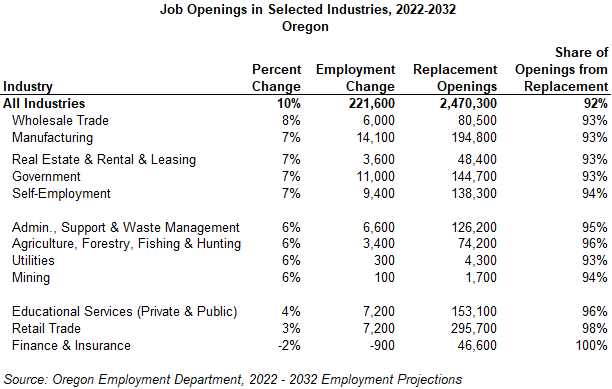Succession Plans: Low Growth Industries with Lots of Job Openings
January 24, 2024The Oregon Employment Department projects total job growth in Oregon of 10% between 2022 and 2032. That translates to about 221,600 new jobs. That’s quite a few jobs added, but about middle of the road in terms of 10-year growth since the year 2000.
However, new jobs are only one element of Oregon’s workforce needs. Every sector will lose workers to retirements or career changes, and most of those workers will need to be replaced. In fact, growth is a relatively small part of the hiring picture. Replacement job openings make up 92% of all opportunities during the next decade. For every growth opening, there will be 11 openings due to worker replacements – nearly 2.5 million openings statewide.
Even industries that aren’t projected to grow at all will have many job opportunities available. In nearly every career path or industry, employers will need more workers as their current workforce retires or changes careers. Let’s look at some slower-growing industries and what kind of replacement needs they will have in the years to come.

A wide range of industries will grow more slowly than average, from natural resources and manufacturing to retail trade and government. Although utilities and mining are small and slow growth fields, there will still be thousands of job opportunities in the next decade from replacement. Even finance and insurance, which is projected to decline in total employment, will have nearly 50,000 projected replacement openings over the next 10 years.
Many replacements openings arise from worker retirements. The workforce is aging in the U.S. and Oregon, and while workers are staying in the workforce later in life than in previous generations, older workers are still very likely to exit the workforce. For more on this topic, see this QualityInfo.org article on the aging of Oregon’s workforce.
Several slow-growth industries have an older than average workforce, especially natural resources and mining, real estate, and utilities, where approximately 30% of workers are 55 and older.
In addition to retirements, openings are created by “transfers” – workers who leave one field for another. The projections capture movement out of an occupation (for example, a bartender leaving the field to become a construction worker), not between jobs in the same field (for example, a bartender leaving a job to start at a different bar). Higher turnover and younger industries, such as retail, have many more transfer openings over the 10-year period.
There are many ways to explore this data for yourself to find out more. Regional and statewide projections on our Projections page can show the unique patterns in your area. We also produce 10-year projections for nearly 800 occupations across the state, which you can access on the publications page or through the Occupation Profiles report. Occupational data are more detailed, but the high replacement-to-growth opening ratio generally holds true there as well.
Let’s look at a specific example. Power Plant Operators are a high-wage occupation that is vital to the slow-growth utility industry. The median wage in Oregon is an enticing $50 an hour, but the field is relatively small and expected to decline 7% from 2022 to 2032, meaning there will be roughly two fewer people doing this job each year across the state.
The declining number of jobs might discourage people from considering this lucrative and important career, but the industry will need to find new workers somewhere: there are about 17 projected openings in this field annually due to replacement needs. There are dozens of examples of occupations that are slow-growing or declining that will still need trained workers to enter the field each year.
Planning for future workforce needs, whether for your business or your career, depends on good information and reliable data. With the tools available at QualityInfo.org, you can prepare yourself for success, even in industries that aren’t leading Oregon’s job growth.